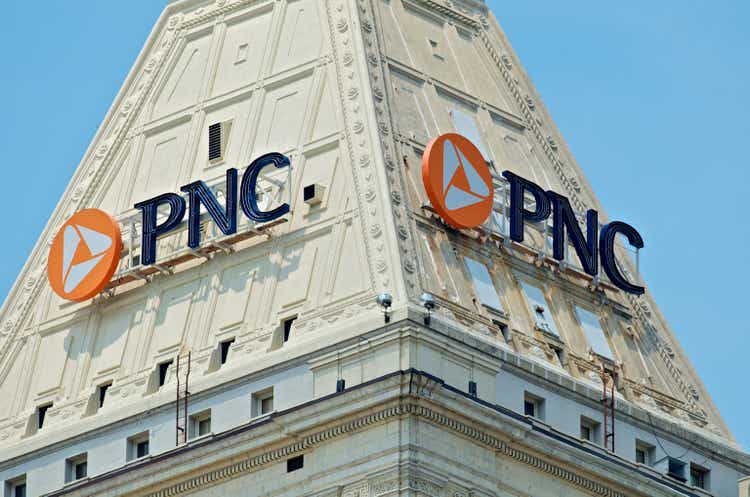
sharrocks
Towards the end of 2020, I offered some thoughts on the business of PNC (NYSE:PNC) after 2020 which was a very eventful year. Besides the impact of the pandemic, PNC closed on the sale of its equity stake in BlackRock (BLK) and announced the purchase of BBVA.
Seeing the rationale behind these deals, amidst reasonable expectations, I had no reason to become involved with cheapness alone, not being enough of an argument.
Some Background
PNC is a broad-based bank with activities ranging across the board: from retail banking to corporate & institutional banking and other activities. Some other activities included a huge stake in BlackRock, which was a huge driver for the business and its stock.
Ahead of the pandemic, the company generated $17.8 billion in sales in the year 2019, driven by $10 billion in net interest income and the remainder from fee income. The company posted pre-tax earnings of $6.5 billion, net earnings of $5.4 billion, equal to more than $11 per share.
The balance sheet revealed $45 billion in equity on a balance sheet totaling $410 billion, as shares trading at roughly twice the book value of $83 per share, with shares awarded 14 times earnings multiple. Shares initially fell on concerns of the pandemic, as the company sold its BlackRock stake in May 2020 for just over $14 billion in net proceeds, as timing of this deal could have been a bit better. The company recycled this money to acquire BBVA USA in November 2020, acquiring this Texas-based bank with $104 billion in assets in a $11.6 billion deal.
This deal was driven by scale and greater exposure to States which are growing their population in the Sunbelt, with the deal set to offset the lost passive income from the BlackRock stake, as the company guided for substantial $900 million in synergies down the road.
What Happened?
Late in 2020 it was anyone’s guess what 2021 earnings power could look like, as I believed that $11 earnings per share power based on the 2019 results, translated into a modest 14-15 times earnings multiple, albeit that many banks shares trade at non-demanding valuations for a time now.
Fast forwarding we have seen a decent 2021 as shares rose to nearly $230 at the start of the year, now back to $155 per share again, marking no returns over the last two years. This is despite a relatively solid 2021, interest rates moving higher and thus providing higher net interest income, as concerns on the economy are really weighing on the shares.
After a more challenging 2020, PNC grew 2021 sales from $16.9 billion to $19.2 billion. Ahead of $800 million in integration costs, pre-tax and pre-provision operating profits rose from $6.6 billion to $7.0 billion. The fact that net earnings nearly doubled to $5.7 billion does not say that much amidst a $779 million recapture of credit loss provision, after the company took huge charges on that front in 2020. Important to note in these figures is that BBVA was only acquired in June 2021, leaving relatively little earnings contribution but a lot of charges taking during the year.
The reality is that 2022 is far from a convincing year as the company keeps muddling through. In the first three quarters of the year, the company has seen a modest increase in revenues of $1.2 billion to $15.4 billion, driven by the BBVA deal and higher interest income, offset by lower fee income. Amidst a net small provision for credit losses ($69 million so far this year) the company posted net earnings of $4.6 billion, or just over $10 per share, making a $14 per share number look realistic this year. Higher earnings per share stem from modest growth, and some share buybacks which has the effect of reducing the tangible book value to just $70 per share here, with shares trading above their book value.
While this earnings power translates into a mere 11 times multiple, we might be seeing higher credit losses going forward as the reality is that the business is not growing at all, certainly after accounting for inflation. Capital ratios in the high single digits, or around 10% leave little room for additional payouts (on top of the dividends) which run at a 3.9% yield, similar to Treasuries here.
Concluding Thought
Right now the situation is a bit tricky. Earnings multiples have fallen from 14 times earnings in 2020 to about 10-11 times here, reflective of higher earnings yields across the board and concerns about future earnings amidst potential new provisions for credit losses. Higher net interest income is beneficial, but with consumers strapped for cash, the funding costs might increase as well, but this is not yet seen in the actual results, at least not to a major extent.
No words are spent on the BBVA integration anymore, let alone potential for more synergies, yet the overall picture looks quite balanced, nothing too great but not too bad either. The business is quite conservative with underwriting, which is comforting, as exposure to business segments should be quite balanced, required as the Tier-1 ratios are a bit lower, as this requires a bit of attention.
Shares have sold off a bit more than the big-banks, exactly for the reason of the regional (and often less diversified) exposure, yet the overall picture looks quite appealing here for a balanced position.


Be the first to comment